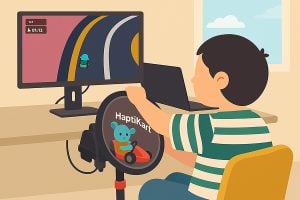
Just as the new Brad Pitt film F1 is hitting movie theaters, another kind of racing experience will be playing on local screens.
HaptiKart, an original video game developed by Johns Hopkins engineers in collaboration with the Kennedy Krieger Institute, is an interactive driving experience that provides valuable insight into how children and young adults with autism learn from their environment. The racing simulator introduces subtle delays to either the visual feedback displayed on the screen or the physical feedback transmitted through the user’s steering wheel. This allows researchers to determine which sensation each player relies on more while driving.
The team’s study was published in PLOS Digital Health.

Jeremy Brown
“We took an off-the-shelf video game steering wheel, which provides force feedback, and built a video game around it that allowed us to adapt the feedback (visual and haptic) for the particular study we were running,” said study co-author Jeremy Brown, associate professor of mechanical engineering and director of the Haptics and Medical Robotics Lab at the Johns Hopkins Whiting School of Engineering. “Haptic devices are becoming more ubiquitous in our everyday lives, and harnessing these technologies to develop better diagnostic and therapeutic tools will benefit not only clinicians but their patients as well.”
In the study, 81 participants between the ages of 8 and 31 played the custom-built HaptiKart videogame in a quiet, light-controlled room using a Logitech G29 steering wheel, an MSI GS66 Stealth laptop, and a Dell monitor adjusted to eye level. Researchers found that those with autism were significantly more likely to rely on physical sensations rather than visual cues while playing the game. This tendency was strongest among individuals with more pronounced autism symptoms and lower IQ scores.
The team suggests HaptiKart may serve as a quick, easy way to help therapists and educators tailor interventions based on how each child learns best. The game takes five minutes to play, requires minimal instruction, and could be used in clinics, schools, or even at home. Brown said combining engaging video games with innovative technologies is a promising approach to help children with autism learn new skills by leveraging their unique sensory preferences.
The research team hopes to expand HaptiKart for even younger children and explore its use as both a diagnostic and therapeutic tool.